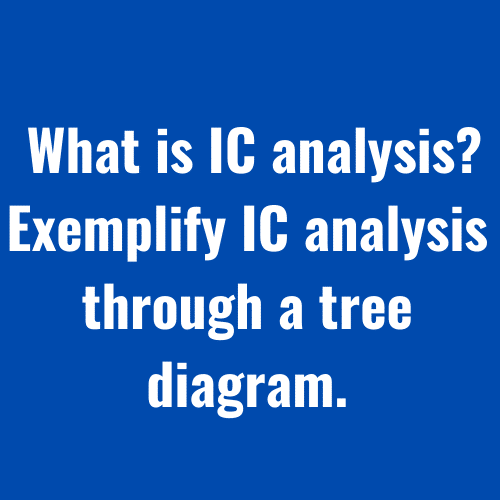Question: What is IC analysis? Discuss IC analysis through a tree diagram.
The key concept of IC analysis
Immediate constituent analysis, also known as IC analysis in linguistics, is a method of grammatical analysis that divides sentences into sequential levels, or elements, until the final level, each element consisting of only one word or meaningful part of the word. An element is any world or construction that enters into some large construction. The first of the instant elements in the sentence “The old man has fled” will be between “The old man” and “has fled”. The immediate elements of “the old man” are “the” and “old man”. The next level is divided into “old” and “man”. Now, we cannot further divide the NP (The old man) since we have separated every constituent of the NP. Such a kind of analysis is simply called IC analysis. The term was coined by the American linguist Leonard Bloomfield in 1933, although the underlying principle is common both to the traditional practice of parsing and to many modern systems of grammatical analysis.
আইসি বিশ্লেষণের মূল ধারণা
তাত্ক্ষণিক উপাদান বিশ্লেষণ, যা ভাষাবিজ্ঞানে আইসি বিশ্লেষণ নামেও পরিচিত, ব্যাকরণগত বিশ্লেষণের একটি পদ্ধতি যা বাক্যগুলিকে অনুক্রমিক স্তরে বা উপাদানগুলিতে বিভক্ত করে, চূড়ান্ত স্তর পর্যন্ত, প্রতিটি উপাদান শুধুমাত্র একটি শব্দ বা শব্দের অর্থপূর্ণ অংশ নিয়ে গঠিত। একটি উপাদান হল যে কোন পৃথিবী বা নির্মাণ যা কিছু বড় নির্মাণে প্রবেশ করে। “”বৃদ্ধ ব্যক্তিটি পালিয়ে গেছে” বাক্যের তাত্ক্ষণিক উপাদানগুলির মধ্যে প্রথমটি “বৃদ্ধ ব্যক্তিটি” এবং “পালিয়ে গেছে” এর মধ্যে হবে। “বৃদ্ধ ব্যক্তিটি” এর তাত্ক্ষণিক উপাদানগুলি হল “দ্য” এবং “বুড়ো মানুষ”। পরবর্তী স্তরটি “বৃদ্ধ” এবং “মানুষ” এ বিভক্ত। এখন, আমরা এনপি (“বৃদ্ধ ব্যক্তিটি”) কে আরও বিভক্ত করতে পারি না কারণ আমরা এনপির প্রতিটি উপাদানকে আলাদা করেছি। এই ধরনের বিশ্লেষণকে সহজভাবে বলা হয় আইসি বিশ্লেষণ। আইসি বিশ্লেষণ টার্মটি আমেরিকান ভাষাতাত্ত্বিক লিওনার্ড ব্লুমফিল্ড 1933 সালে প্রণয়ন করেছিলেন, যদিও অন্তর্নিহিত নীতিটি শব্দ বিশ্লেষণের প্রচলিত অনুশীলন এবং ব্যাকরণগত বিশ্লেষণের অনেক আধুনিক পদ্ধতির ক্ষেত্রে সাধারণ।
IC analysis with a tree diagram
In phrase structure grammar, IC-analysis divides a sentence into main parts or immediate elements and these elements are further divided into immediate elements. The process continues until irreducible elements are reached, for example, until each element consists of only one word or a meaningful part of a word. Let’s analyze in the following tree diagram:
একটি বৃক্ষ চিত্রের সাথে আইসি বিশ্লেষণ
একটি ফ্রেজ স্ট্রাকচার ব্যাকরণে, আইসি-বিশ্লেষণ একটি বাক্যকে প্রধান অংশ বা তাৎক্ষণিক উপাদানে বিভক্ত করে এবং এই উপাদানগুলিকে আরও তাৎক্ষণিক উপাদানে বিভক্ত করা হয়। প্রক্রিয়াটি অব্যাহত থাকে যতক্ষণ না উপাদানগুলিকে আর কমানো সম্ভব নয় এমন অবস্থায় পৌঁছে যায়, উদাহরণস্বরূপ, যতক্ষণ না প্রতিটি উপাদান শুধুমাত্র একটি শব্দ বা একটি শব্দের অর্থপূর্ণ অংশ নিয়ে গঠিত। আসুন নিম্নলিখিত গাছের চিত্রটিতে বিশ্লেষণ করি:
The above tree diagram divides the whole sentence into two immediate constituents or parts – “this tree” and “illustrates IC-analysis according to the constituency relation”; these two constituents are further divided into the immediate constituents “this” and “tree” and “illustrates IC-analysis” and “according to the constituency relation”. In detail, we can illustrate the above tree diagram in the following way:
উপরের গাছের চিত্রটি পুরো বাক্যটিকে দুটি তাত্ক্ষণিক উপাদান বা অংশে বিভক্ত করে – “এই গাছ” এবং “নির্বাচনী সম্পর্ক অনুসারে আইসি -বিশ্লেষণকে ব্যাখ্যা করে”; এই দুটি উপাদানকে তাত্ক্ষণিক উপাদান “এই” এবং “গাছ” এবং “আইসি-বিশ্লেষণকে ব্যাখ্যা করে” এবং “নির্বাচনী সম্পর্ক অনুসারে” ভাগ করা হয়েছে। বিস্তারিতভাবে, আমরা নিম্নলিখিত উপায়ে উপরের গাছের চিত্রটি চিত্রিত করতে পারি:
First step: S (sentence) is divided into two parts or constituents such as NP (this tree) and VP (“illustrates IC-analysis according to the constituency relation”).
Second step: NP is divided into two constituents such as D (this) and N (tree)
Third step: VP is divided into two parts such as VP (illustrates IC analysis) and PP1 (according to the constituency relation).
Fourth step: VP is divided into parts such as V (illustrates) and N (IC analysis).
Fifth step: PP1 is divided into two parts such as P1 (according) PP2 (to the constituency relation).
Sixth step: PP2 is divided into two parts P2 (to) NP (the constituency relation).
Seventh step: NP is divided into three parts such D (the) A (constituency) and N (relation).
So, after analyzing the immediate constituents of the sentence “This tree illustrates IC analysis according to the constituency relation”, each meaningful element of the sentence has reached its final level.
N:B: S = sentence, NP = noun phrase, VP = verbal phrase, D = determiner, N = noun, PP1 = prepositional phrase one, P1= phrase one, PP2 = prepositional phrase two, P2 = preposition, and A = adjective.
